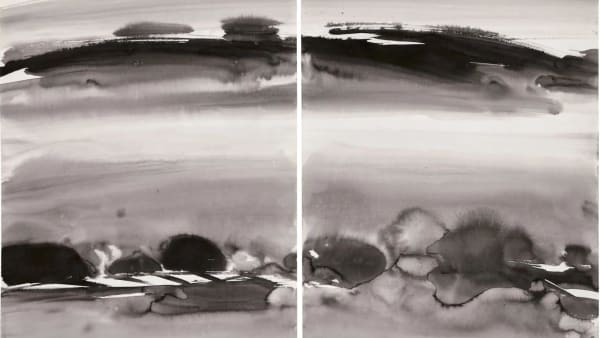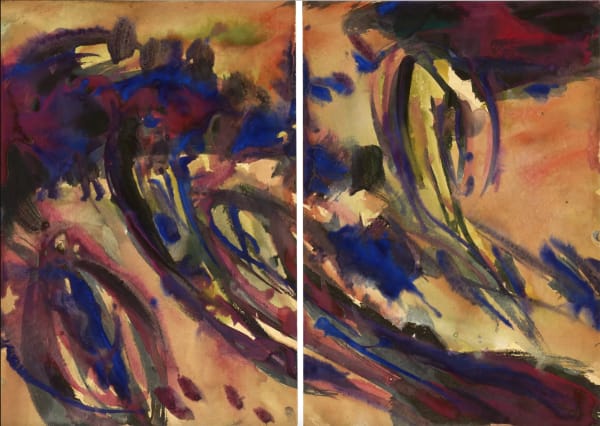Chinese painting is never abstract. As T'ang Haywen says himself, his is an art that never loses touch with the sensible world. In his ink works, which are at the border between abstraction and figuration, the artist creates poetic landscapes. These works are either done masterfully in ink, or present colourful , almost expressionnistic watercolours.
T'ang Haywen's works - be they in the traditional ink, or in watercolour and gouache, unveil the immense talent of a painter that the public is rediscovering only now. contemporary with Zao Wou-Ki and Chu Teh-Chun, the trio are considered nowadays some of the most important painters of the Post-war school of Paris.
During the CHINA-PARIS exhibition of 1988 at the Taipei Museum of Art, the curator says : Zao Wou-Ki, Chu Teh-Chun and T'ang Haywen combined Chinese calligraphy and philosophy in a non-representational art form and distinguished themselves as abstract expressionist painters.
In this climate of the triumph of abstraction during the Post-War years, T'ang himself speaks of his position on art as a radical stance:
" ...Undoubtedly, the play of abstraction can stimulate the mind momentarily, but once the moment of deciphering and understanding has passed, nothing blossoms in the sensibility, the figure is dead, even the memory of it fades. Our deep sensibility, linked to the unconscious, can only develop and grow when nourished by the tangible, i.e., in the case of painting, by the recall in our conscious memory of deep and lasting sensitive experiences we have had in the real world. It is from a certain more or less preponderant material figuration that painting can develop, renew itself without losing itself, and unfold in the realms of affectivity and spirituality..."
The art of T'ang Haywen is neither figurative or non-figurative, neither abstract nor representational. His is an art of total freedom, of philosophical landscapes.
-
 T'ang Haywen, Sans titre, 1972
T'ang Haywen, Sans titre, 1972 -
 T'ang HaywenSans titre, 1983-84Gouache on paper30 x 42 cm
T'ang HaywenSans titre, 1983-84Gouache on paper30 x 42 cm
DiptychSigned on the lower right corner. -
 T'ang HaywenSans titre, 1985Ink on Arches paper10.5 x 11 cmSigned on the lower right corner.
T'ang HaywenSans titre, 1985Ink on Arches paper10.5 x 11 cmSigned on the lower right corner. -
 T'ang HaywenSans titre, 1983-84Gouache and ink on paper
T'ang HaywenSans titre, 1983-84Gouache and ink on paper
30 x 42 cm
DiptychSigned on the lower right corner. -
 T'ang Haywen, Sans titre, 1983-84
T'ang Haywen, Sans titre, 1983-84 -
 T'ang HaywenSans titre, 1985Watercolour on paper22.3 x 38 cm
T'ang HaywenSans titre, 1985Watercolour on paper22.3 x 38 cm
Diptych -
 T'ang HaywenSans titre, 1972-3Ink on Kyro board70 x 100 cm
T'ang HaywenSans titre, 1972-3Ink on Kyro board70 x 100 cm
27 1/2 x 39 3/8 in.
Diptych -
 T'ang HaywenSans titre, 1970Ink on Kyro board70 x 100 cm
T'ang HaywenSans titre, 1970Ink on Kyro board70 x 100 cm
27 1/2 x 39 3/8 in.
Diptych -
 T'ang HaywenSans titre, 1974Ink on Kyro paper70 x 100 cm (diptych)Signed in red ink on the lower right corner
T'ang HaywenSans titre, 1974Ink on Kyro paper70 x 100 cm (diptych)Signed in red ink on the lower right corner -
 T'ang HaywenSans titre, 1980Watercolour on Arches paper11.5 x 23 cm
T'ang HaywenSans titre, 1980Watercolour on Arches paper11.5 x 23 cm -
 T'ang HaywenSans titre, 1985Ink on Arches wove paper.70 x 100 cm
T'ang HaywenSans titre, 1985Ink on Arches wove paper.70 x 100 cm
DiptychSigned on the lower right corner.











